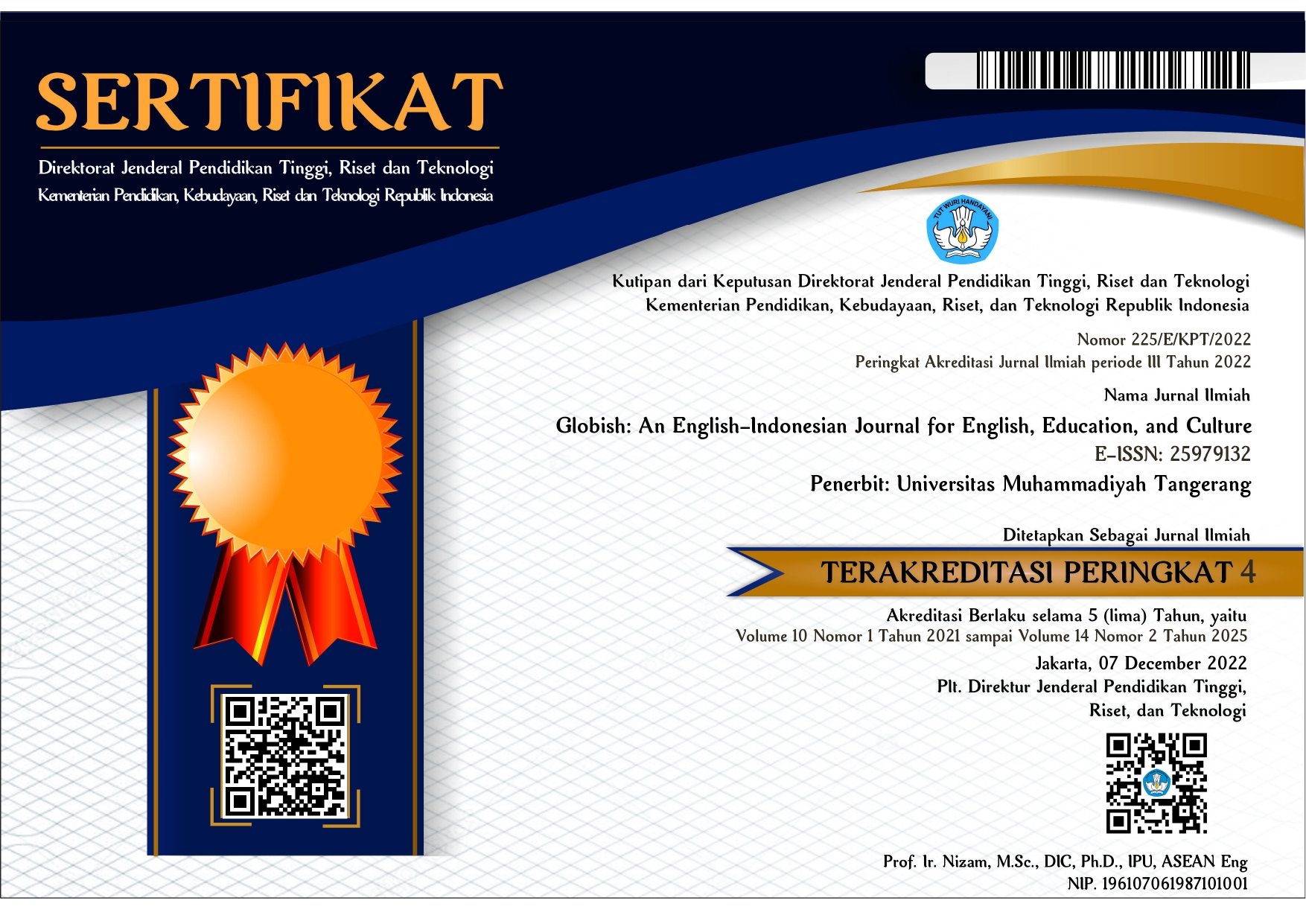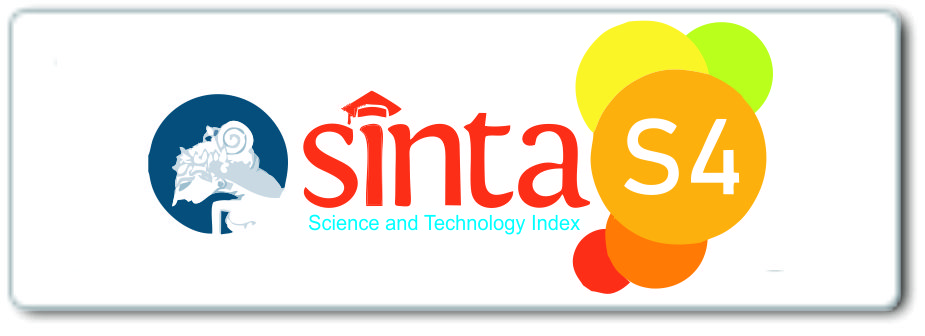Willingness to Communicate (WTC) in English: Insights from Pre-service EFL Teachers
Abstract
Oral language skill among EFL students can be indicated from willingness to communicate in English. This current study aimed to investigate pre-service EFL teachers’ (PST) willingness to communicate (WTC) in English across rural setting. A survey study with 217 EFL students as the participants selected through a convenience sampling was employed. A questionnaire of the willingness was distributed through in-class meeting and online mode. The first result revealed that there is a variety of perceptions on oral skill willingness, self-confidence, and English use frequency. The second result showed that from junior and senior PST, it is noted that seniors mostly overdid juniors in terms of willingness to speak English. Meanwhile, female PST had greater levels of WTC if compared to that of the males. In conclusion, WTC not only emerge to be a valuable aspect in learning oral language skills, but also impact on other English skills indirectly.
Keywords
Full Text:
PDFReferences
Ai, B., Li, X., & Li, G. (2022). When City Meets Rural: Exploring Pre-Service Teachers’ Identity Construction When Teaching in Rural Schools. SAGE Open, 12(1), 21582440221079910. https://doi.org/10.1177/21582440221079910
Amiryousefi, M. (2018). Willingness to communicate, interest, motives to communicate with the instructor, and L2 speaking: a focus on the role of age and gender. Innovation in Language Learning and Teaching, 12(3), 221–234. https://doi.org/10.1080/17501229.2016.1170838
Ayuningtyas, M., & Wiyanah, S. (2023). Teacher ’ s Methods in Teaching Integrated Listening and Speaking at English Department. 12(2), 130–144.
Bergil, A. S. (2016). The Influence of Willingness to Communicate on Overall Speaking Skills among EFL Learners. Procedia - Social and Behavioral Sciences, 232, 177–187. https://doi.org/https://doi.org/10.1016/j.sbspro.2016.10.043
Cao, Y. K., & Wei, W. (2019). Willingness to communicate from an English as an International Language (EIL) perspective: The case of Macau. System, 87, 102149. https://doi.org/https://doi.org/10.1016/j.system.2019.102149
Chichon, J. (2019). Factors influencing overseas learners’ Willingness to Communicate (WTC) on a pre-sessional programme at a UK university. Journal of English for Academic Purposes, 39, 87–96. https://doi.org/https://doi.org/10.1016/j.jeap.2019.04.002
Collins, G. G., Goforth, A. N., & Ambrose, L. M. (2016). The Effects of Teacher Professional Development on Rural Students’ Lexical Inferencing Skills. Rural Special Education Quarterly, 35(3), 20–29. https://doi.org/10.1177/875687051603500304
Darasawang, P., & Reinders, H. (2021). Willingness to communicate and second language proficiency: A correlational study. Education Sciences, 11(9). https://doi.org/10.3390/educsci11090517
Deng, F., & Peng, J.-E. (2021). Sustaining Short-Term Exchange Students’ Willingness to Communicate in Second Language in Multilingual Classrooms. RELC Journal, 00336882211035590. https://doi.org/10.1177/00336882211035590
Fargas-Malet, M., & Bagley, C. (2021). Is small beautiful? A scoping review of 21st-century research on small rural schools in Europe. European Educational Research Journal, 21(5), 822–844. https://doi.org/10.1177/14749041211022202
Grant, S. (2020). Effects of intensive EFL immersion programmes on willingness to communicate. The Language Learning Journal, 48(4), 442–453. https://doi.org/10.1080/09571736.2017.1422274
Halupka-Rešetar, S., Knežević, L., & Topalov, J. (2018). Revisiting willingness to communicate in English as a foreign language: the Serbian perspective. Journal of Multilingual and Multicultural Development, 39(10), 912–924. https://doi.org/10.1080/01434632.2018.1454456
Hargreaves, L., Kvalsund, R., & Galton, M. (2009). Reviews of research on rural schools and their communities in British and Nordic countries: Analytical perspectives and cultural meaning. International Journal of Educational Research, 48(2), 80–88. https://doi.org/https://doi.org/10.1016/j.ijer.2009.02.001
Hayes, D. (2009). Learning Language, Learning Teaching: Episodes from the Life of a Teacher of English in Thailand. RELC Journal, 40(1), 83–101. https://doi.org/10.1177/0033688208101446
Hillyard, S. (2020). The enduring insignificance of a school for its village: An English case study. Journal of Rural Studies, 80, 618–625. https://doi.org/https://doi.org/10.1016/j.jrurstud.2020.09.006
Hoover, J. J., Soltero-González, L., Wang, C., & Herron, S. (2019). Sustaining a Multitiered System of Supports for English Learners in Rural Community Elementary Schools. Rural Special Education Quarterly, 39(1), 4–16. https://doi.org/10.1177/8756870519847466
Jin, S., & Lee, H. (2022). Willingness to Communicate and its High-Evidence Factors: A Meta-Analytic Structural Equation Modeling Approach. Journal of Language and Social Psychology, 41(6), 716–745. https://doi.org/10.1177/0261927X221092098
Kruk, M. (2021). Changes in self-perceived willingness to communicate during visits to Second Life: a case study. The Language Learning Journal, 49(2), 240–250. https://doi.org/10.1080/09571736.2018.1554692
Kruk, M. (2022). Dynamicity of perceived willingness to communicate, motivation, boredom and anxiety in Second Life: the case of two advanced learners of English. Computer Assisted Language Learning, 35(1–2), 190–216. https://doi.org/10.1080/09588221.2019.1677722
Lee, J. S., & Chen Hsieh, J. (2019). Affective variables and willingness to communicate of EFL learners in in-class, out-of-class, and digital contexts. System, 82, 63–73. https://doi.org/https://doi.org/10.1016/j.system.2019.03.002
Lee, J. S., & Lee, K. (2019). Affective factors, virtual intercultural experiences, and L2 willingness to communicate in in-class, out-of-class, and digital settings. Language Teaching Research, 24(6), 813–833. https://doi.org/10.1177/1362168819831408
Lee, J. S., Lee, K., & Chen Hsieh, J. (2019). Understanding willingness to communicate in L2 between Korean and Taiwanese students. Language Teaching Research, 26(3), 455–476. https://doi.org/10.1177/1362168819890825
Li, C., Dewaele, J.-M., Pawlak, M., & Kruk, M. (2022). Classroom environment and willingness to communicate in English: The mediating role of emotions experienced by university students in China. Language Teaching Research, 13621688221111624. https://doi.org/10.1177/13621688221111623
Lopez, M. P. S. (2021). Exploring linguistically responsive teaching for English learners in rural, elementary classrooms: From theory to practice. Language Teaching Research, 13621688211051036. https://doi.org/10.1177/13621688211051035
MacIntyre, P. D., & Wang, L. (2021). Willingness to communicate in the L2 about meaningful photos: Application of the pyramid model of WTC. Language Teaching Research, 25(6), 878–898. https://doi.org/10.1177/13621688211004645
Mahmoodi, M.-H., & Moazam, I. (2014). Willingness to Communicate (WTC) and L2 Achievement: The Case of Arabic Language Learners. Procedia - Social and Behavioral Sciences, 98, 1069–1076. https://doi.org/https://doi.org/10.1016/j.sbspro.2014.03.518
Mahmud, R. (2020). Family Socioeconomic Determinants and Students’ Demand for Private Supplementary Tutoring in English in Urban and Rural Bangladesh. Education and Urban Society, 53(7), 831–851. https://doi.org/10.1177/0013124520974332
Mukeredzi, T. G. (2016). The Nature of Professional Learning Needs of Rural Secondary School Teachers: Voices of Professionally Unqualified Teachers in Rural Zimbabwe. SAGE Open, 6(2), 2158244016643142. https://doi.org/10.1177/2158244016643142
Mulyono, H., & Saskia, R. (2021). Affective variables contributing to Indonesian EFL students’ willingness to communicate within face-to-face and digital environments. Cogent Education, 8(1), 1911282. https://doi.org/10.1080/2331186X.2021.1911282
Pavelescu, L. M. (2023). Emotion, motivation and willingness to communicate in the language learning experience: A comparative case study of two adult ESOL learners. Language Teaching Research, 13621688221146884. https://doi.org/10.1177/13621688221146884
Pawlak, M., & Mystkowska-Wiertelak, A. (2015). Investigating the dynamic nature of L2 willingness to communicate. System, 50, 1–9. https://doi.org/https://doi.org/10.1016/j.system.2015.02.001
Plantika, S., & Adnan, A. (2021). The Correlation between Students’ Speaking Anxiety and Their Speaking Ability. Journal of English Language Teaching, 10(1), 121–128. http://ejournal.unp.ac.id/index.php/jelt
Reagan, E. M., Hambacher, E., Schram, T., McCurdy, K., Lord, D., Higginbotham, T., & Fornauf, B. (2019). Place matters: Review of the literature on rural teacher education. Teaching and Teacher Education, 80, 83–93. https://doi.org/https://doi.org/10.1016/j.tate.2018.12.005
Ruecker, T. (2020). The Impact of Neoliberal Evaluation Systems on Rural Schools, Teachers, and their Bilingual Learners. Educational Policy, 36(6), 1288–1314. https://doi.org/10.1177/0895904820961009
Ruiz, M. I. (2019). Beyond Traditional Response to Intervention: Helping Rural Educators Understand English Learners’ Needs. Rural Special Education Quarterly, 39(1), 35–53. https://doi.org/10.1177/8756870519894661
Saha, M. (2023). English teachers’ attitudes towards learners: Effects on the rural pedagogies in Bangladesh. Ampersand, 10, 100107. https://doi.org/https://doi.org/10.1016/j.amper.2022.100107
Sato, R. (2019). Fluctuations in an EFL teacher’s willingness to communicate in an English-medium lesson: an observational case study in Japan. Innovation in Language Learning and Teaching, 13(2), 105–117. https://doi.org/10.1080/17501229.2017.1375506
Sharif, S., & Channa, L. A. (2022). Lived narratives: Female investment and identity negotiation in learning English in rural Pakistan. Linguistics and Education, 72, 101119. https://doi.org/https://doi.org/10.1016/j.linged.2022.101119
Sheybani, M. (2019). The relationship between EFL Learners’ Willingness to Communicate (WTC) and their teacher immediacy attributes: A structural equation modelling. Cogent Psychology, 6(1), 1607051. https://doi.org/10.1080/23311908.2019.1607051
Subtirelu, N. (2014). A language ideological perspective on willingness to communicate. System, 42, 120–132. https://doi.org/https://doi.org/10.1016/j.system.2013.11.004
Syed, H., Memon, S., Chachar, Z. A., Zameer, S., & Shah, T. (2021). Willingness to communicate in a second language and the promise of complex dynamic systems theory: A narrative review. Research in Education, 113(1), 41–58. https://doi.org/10.1177/00345237211031261
Wang, C., & Tseng, W.-T. (2020). Toward an Instructional WTC-Mediated Model for L2 Classroom Interaction. SAGE Open, 10(3), 2158244020943524. https://doi.org/10.1177/2158244020943524
Wang, J., Tigelaar, D. E. H., & Admiraal, W. (2019). Connecting rural schools to quality education: Rural teachers’ use of digital educational resources. Computers in Human Behavior, 101, 68–76. https://doi.org/https://doi.org/10.1016/j.chb.2019.07.009
Wood, D. (2016). Willingness to communicate and second language speech fluency: An idiodynamic investigation. System, 60, 11–28. https://doi.org/https://doi.org/10.1016/j.system.2016.05.003
Yao, C. (2021). Is a One-Way English Immersion Teaching Approach Equitable to Those Chinese Non-English Major Students from Rural Areas? Education and Urban Society, 54(4), 470–486. https://doi.org/10.1177/00131245211027514
Yashima, T., MacIntyre, P. D., & Ikeda, M. (2016). Situated willingness to communicate in an L2: Interplay of individual characteristics and context. Language Teaching Research, 22(1), 115–137. https://doi.org/10.1177/1362168816657851
Zheng, C., Liang, J.-C., Chai, C. S., Chen, X., & Liu, H. (2023). Comparing high school students’ online self-regulation and engagement in English language learning. System, 115, 103037. https://doi.org/https://doi.org/10.1016/j.system.2023.103037
Zhou, L., Xi, Y., & Lochtman, K. (2023). The relationship between second language competence and willingness to communicate: the moderating effect of foreign language anxiety. Journal of Multilingual and Multicultural Development, 44(2), 129–143. https://doi.org/10.1080/01434632.2020.1801697
DOI: http://dx.doi.org/10.31000/globish.v13i1.9956
Article Metrics
Abstract - 1290 PDF - 599Refbacks
- There are currently no refbacks.
Globish
Program Studi Pendidikan Bahasa Inggris
Fakultas Keguruan dan Ilmu Pendidikan
Universitas Muhammadiyah Tangerang
Jl. Perintis Kemerdekaan I/33, Cikokol
Kota Tangerang, Indonesia
e-mail: globish_journal@umt.ac.id
Globish (p-ISSN: 2301-9913 | e-ISSN: 2301-9913) is licensed under a Creative Commons Attribution-ShareAlike 4.0 International License.









